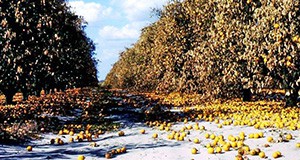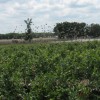
Citrus trees are evergreen, never become fully dormant, and cannot withstand temperatures as low as those tolerated by deciduous trees. But citrus trees can become preconditioned or acclimated to cool air temperatures that occur in late fall and winter. One of the best ways to lessen cold injury and to hasten recovery from cold damage is to maintain healthy trees. This five-page fact sheet discusses the symptoms of freeze damage and ways to help recover trees that have been damaged. Written by Mongi Zekri, Chris Oswalt, Steve Futch, Gary England, Camilly McAvoy, Laurie Hurner, and Parker Platts, and published by the Horticultural Sciences Department.
http://edis.ifas.ufl.edu/hs1250
Tag: Gary England
Southern Highbush Blueberry Cultivars from the University of Florida
 Many improved southern highbush cultivars have been developed by the University of Florida breeding program since the initial releases of ‘Sharpblue’, ‘Flordablue’, and ‘Avonblue’ in the mid-1970s. Today there are more blueberry cultivar choices available for Florida growers than ever before, but in every case, cultivar selection involves weighing the advantages and disadvantages of a cultivar relative to the grower’s needs. Unfortunately, there are no perfect cultivars suited for every location and management system. This 10-page fact sheet categorizes southern highbush cultivars into four groups: major cultivars, secondary cultivars, new options, and historical cultivars. Proper cultivar selection is critical to a successful blueberry enterprise, and growers should seek information from multiple sources, including their local county Extension office. Written by J.G. Williamson, J.W. Olmstead, G.K. England, and P.M. Lyrene, and published by the UF Department of Horticultural Sciences, April 2014.
Many improved southern highbush cultivars have been developed by the University of Florida breeding program since the initial releases of ‘Sharpblue’, ‘Flordablue’, and ‘Avonblue’ in the mid-1970s. Today there are more blueberry cultivar choices available for Florida growers than ever before, but in every case, cultivar selection involves weighing the advantages and disadvantages of a cultivar relative to the grower’s needs. Unfortunately, there are no perfect cultivars suited for every location and management system. This 10-page fact sheet categorizes southern highbush cultivars into four groups: major cultivars, secondary cultivars, new options, and historical cultivars. Proper cultivar selection is critical to a successful blueberry enterprise, and growers should seek information from multiple sources, including their local county Extension office. Written by J.G. Williamson, J.W. Olmstead, G.K. England, and P.M. Lyrene, and published by the UF Department of Horticultural Sciences, April 2014.
http://edis.ifas.ufl.edu/hs1245
How to Convert Liquid Fertilizer into Dry Fertilizer in Fertigation for Commercial Vegetable and Fruit Crop Production (HS1200/HS1200)
 In recent years, more and more liquid fertilizers have been used in vegetable and fruit production. Typically, UF/IFAS recommendations are expressed as pounds per acre or kilograms per hectare. Thus, conversion either from a dry fertilizer basis (the UF/IFAS recommendation) to a liquid fertilizer basis, or from a liquid fertilizer source to the UF/IFAS recommended nutrient rate is often required for correct application rate. This 5-page fact sheet helps growers understand the conversion method from liquid to dry fertilizer. Written by Guodong Liu, David Sui, and Gary K. England, and published by the UF Department of Horticultural Sciences, April 2012.
In recent years, more and more liquid fertilizers have been used in vegetable and fruit production. Typically, UF/IFAS recommendations are expressed as pounds per acre or kilograms per hectare. Thus, conversion either from a dry fertilizer basis (the UF/IFAS recommendation) to a liquid fertilizer basis, or from a liquid fertilizer source to the UF/IFAS recommended nutrient rate is often required for correct application rate. This 5-page fact sheet helps growers understand the conversion method from liquid to dry fertilizer. Written by Guodong Liu, David Sui, and Gary K. England, and published by the UF Department of Horticultural Sciences, April 2012.
http://edis.ifas.ufl.edu/hs1200
How to Calculate Fertigation Injection Rates for Commercial Blueberry Production (HS1197)
 To increase nutrient and water use efficiencies and reduce nutrient leaching and environmental concerns, fertigation is recommended for commercial blueberry production. In fact, successful fertigation can enhance sustainability and maximize profitability for commercial blueberry enterprises. One of the key factors in fertigation is the correct calculation of fertilizer injection rate and time for the acreage. This publication helps blueberry growers correctly calculate fertigation injection rates and times and provides reference tables for checking injection rates and times needed for a variety of production scenarios. This 3-page fact sheet was written by Guodong Liu, Jeffrey Williamson, Gary England, and Alicia Whidden, and published by the UF Department of Horticultural Sciences, March 2012.
To increase nutrient and water use efficiencies and reduce nutrient leaching and environmental concerns, fertigation is recommended for commercial blueberry production. In fact, successful fertigation can enhance sustainability and maximize profitability for commercial blueberry enterprises. One of the key factors in fertigation is the correct calculation of fertilizer injection rate and time for the acreage. This publication helps blueberry growers correctly calculate fertigation injection rates and times and provides reference tables for checking injection rates and times needed for a variety of production scenarios. This 3-page fact sheet was written by Guodong Liu, Jeffrey Williamson, Gary England, and Alicia Whidden, and published by the UF Department of Horticultural Sciences, March 2012.
http://edis.ifas.ufl.edu/hs1197